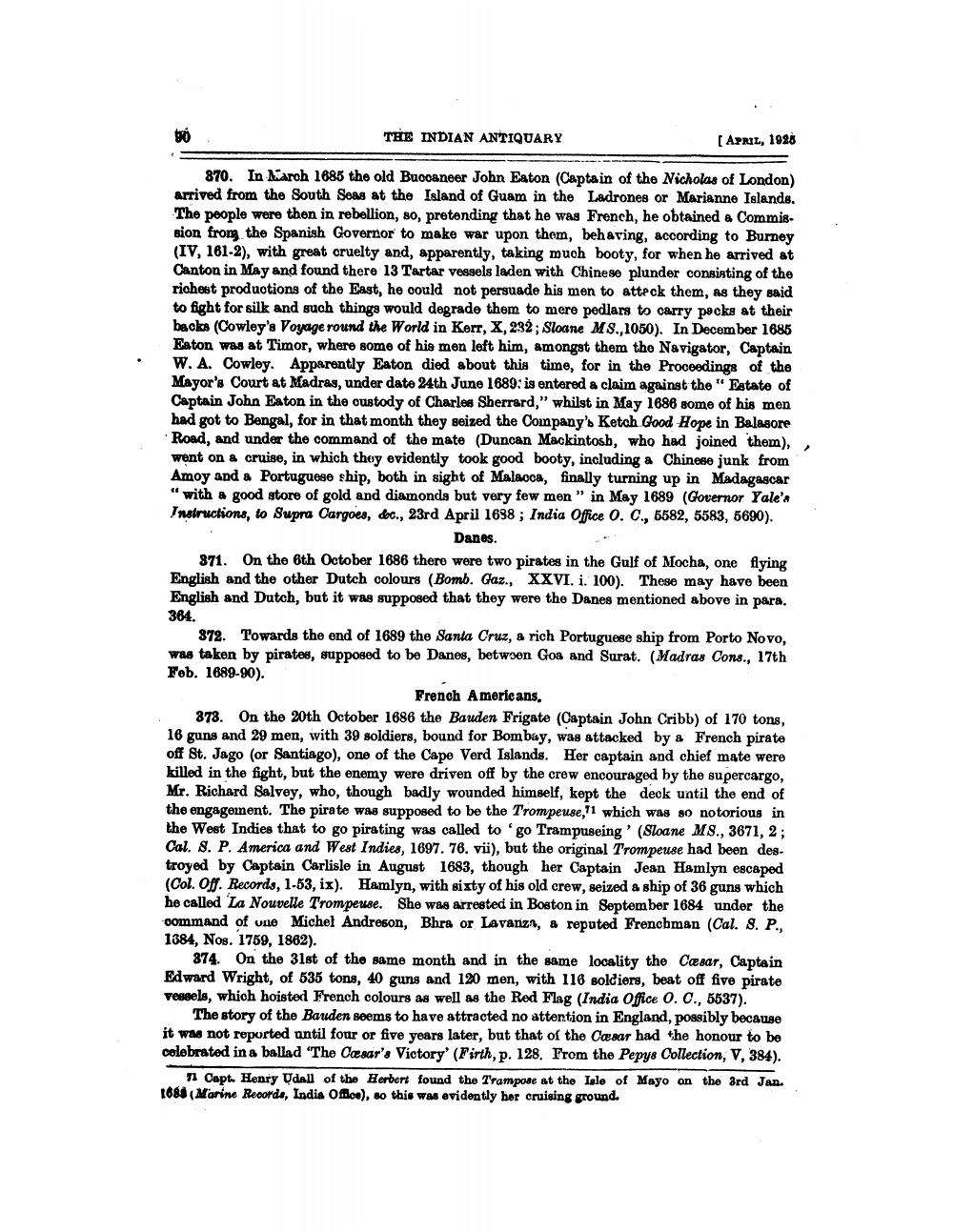________________
THE INDIAN ANTIQUARY
APRIL, 1925
870. In March 1685 the old Buccaneer John Eaton (Captain of the Nicholas of London) arrived from the South Seas at the Island of Guam in the Ladrones or Marianne Islande. The people were then in rebellion, so, pretending that he was French, he obtained a Commission frong the Spanish Governor to make war upon them, beharing, according to Burney (IV, 161-2), with great cruelty and, apparently, taking much booty, for when he arrived at Canton in May and found there 13 Tartar vessels laden with Chinese plunder consisting of the richest productions of the East, he could not persuade his men to atteck them, as they said to fight for silk and such things would degrade them to mere pedlars to carry pocks at their backs (Cowley's Voyage round the World in Kerr, X, 232, Sloane MS.,1050). In December 1685 Eaton was at Timor, where some of his men left him, amongst them the Navigator, Captain W. A. Cowley. Apparently Eaton died about this time, for in the Proceedings of the Mayor's Court at Madras, under date 24th June 1689: is entered a claim against the "Estate of Captain John Eaton in the custody of Charles Sherrard," whilst in May 1686 some of his men had got to Bengal, for in that month they seized the Coinpany's Ketoh Good Hope in Balasore Road, and under the command of the mate (Duncan Mackintosh, who had joined them), went on a cruise, in which they evidently took good booty, including a Chinese junk from Amoy and a Portuguese ship, both in sight of Malacca, finally turning up in Madagascar “with a good store of gold and diamonds but very few men” in May 1689 (Governor Yale's Instructions, to Supra Cargoes, doc., 23rd April 1638 ; India Office 0. C., 5582, 5583, 5690).
Danes. 871. On the 6th October 1686 there were two pirates in the Gulf of Mocha, one flying English and the other Dutch colours (Bomb. Gaz., XXVI. i. 100). These may have been English and Dutch, but it was supposed that they were the Danes mentioned above in para. 364.
872. Towards the end of 1689 the Santa Cruz, a rich Portuguese ship from Porto Novo, was taken by pirates, supposed to be Danes, betwsen Goa and Surat. (Madras Cons., 17th Feb. 1689-90).
French Americans. 373. On the 20th October 1686 the Bauden Frigate (Captain John Cribb) of 170 tons, 16 guns and 29 men, with 39 soldiers, bound for Bombay, was attacked by a French pirate off St. Jago (or Santiago), one of the Cape Verd Islands. Her captain and chief mate were killed in the fight, but the enemy were driven off by the crew encouraged by the supercargo, Mr. Richard Salvey, who, though badly wounded himself, kept the deck until the end of the engagement. The pirate was supposed to be the Trompeuse, 11 which was so notorious in the West Indies that to go pirating was called to 'go Trampuseing' (Sloane M8., 3671, 2; Cal. 8. P. America and West Indies, 1697. 76. vü), but the original Trompeuse had been destroyed by Captain Carlisle in August 1683, though her Captain Jean Hamlyn escaped (Col. Off Records, 1-53, ix). Hamlyn, with sixty of his old crew, seized a ship of 36 guns which ho called 'La Nouvelle Trompeuse. She was arrested in Boston in September 1684 under the command of une Michel Andreson, Bhra or Lavanza, & reputed Frenchman (Cal. 8. P., 1384, Nos. 1759, 1862).
874. On the 31st of the same month and in the same locality the Cæsar, Captain Edward Wright, of 535 tons, 40 guns and 120 men, with 116 soldiers, beat off five pirate vessels, which hoisted French colours as well as the Red Flag (India Office 0. C., 5537).
The story of the Bauden seems to have attracted no attention in England, possibly because it was not reported until four or five years later, but that of the Cæsar had the honour to be celebrated in a ballad "The Cæsar's Victory' (Firth, p. 128. From the Pepys Collection, V, 384).
1 Capt. Henry Udall of the Herbert found the Trampore at the Lale of Mayo on the 3rd Jan. 1688 (Marine Reoorde, India Office), so this was evidently her cruising ground.




